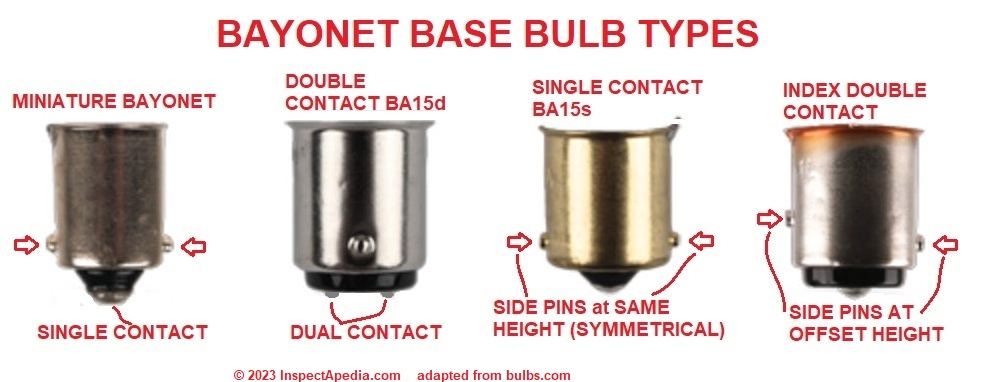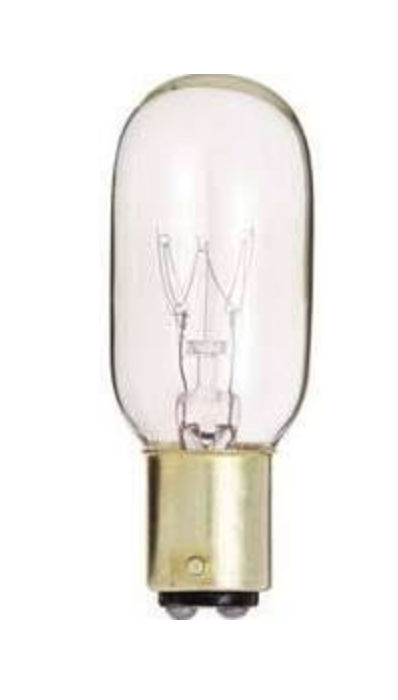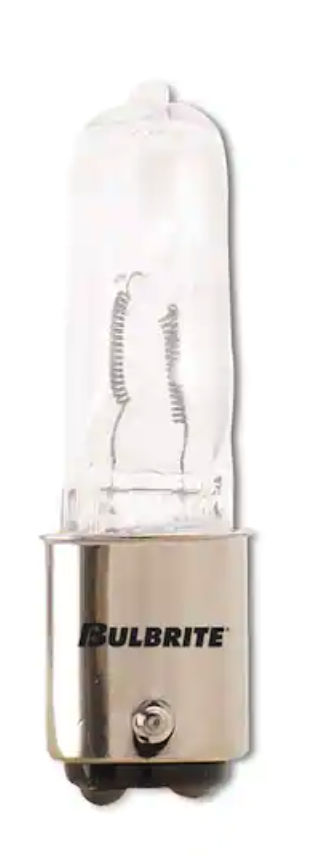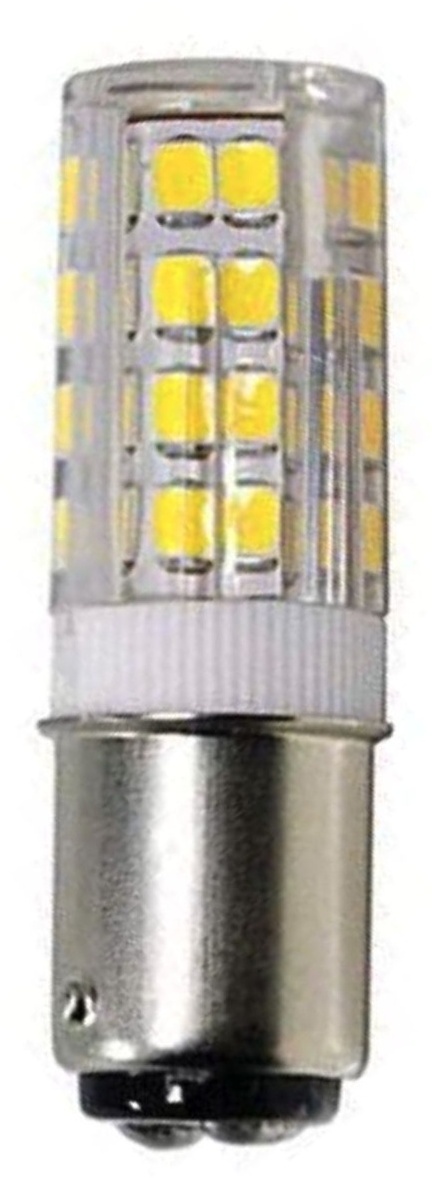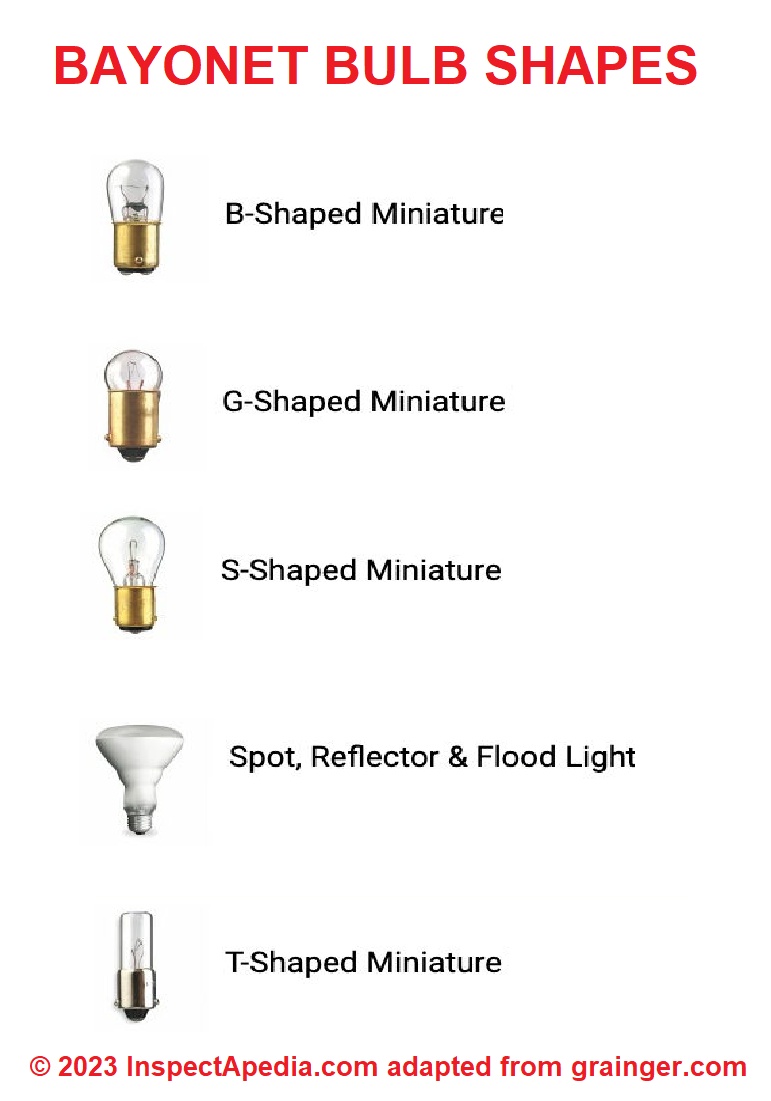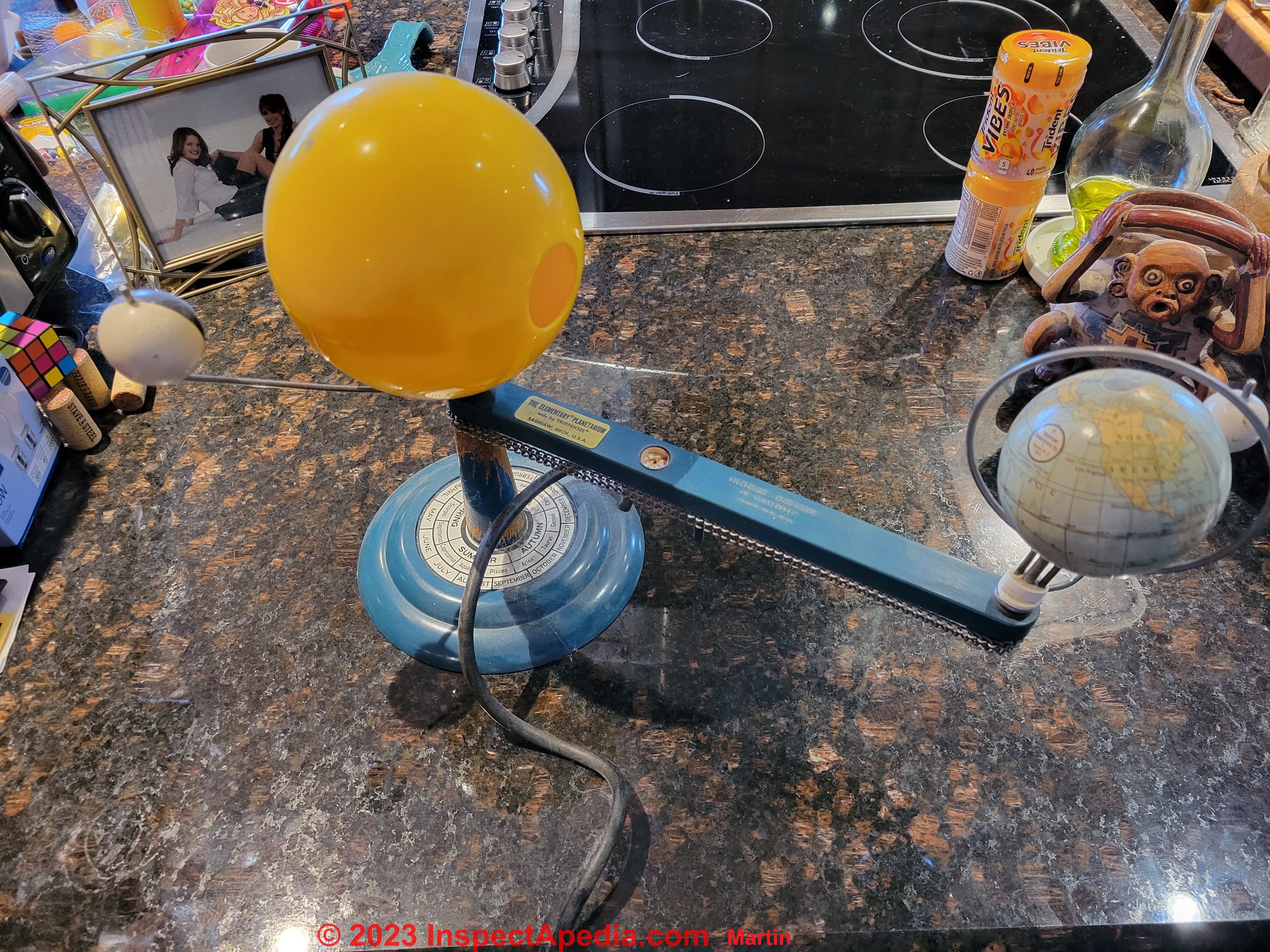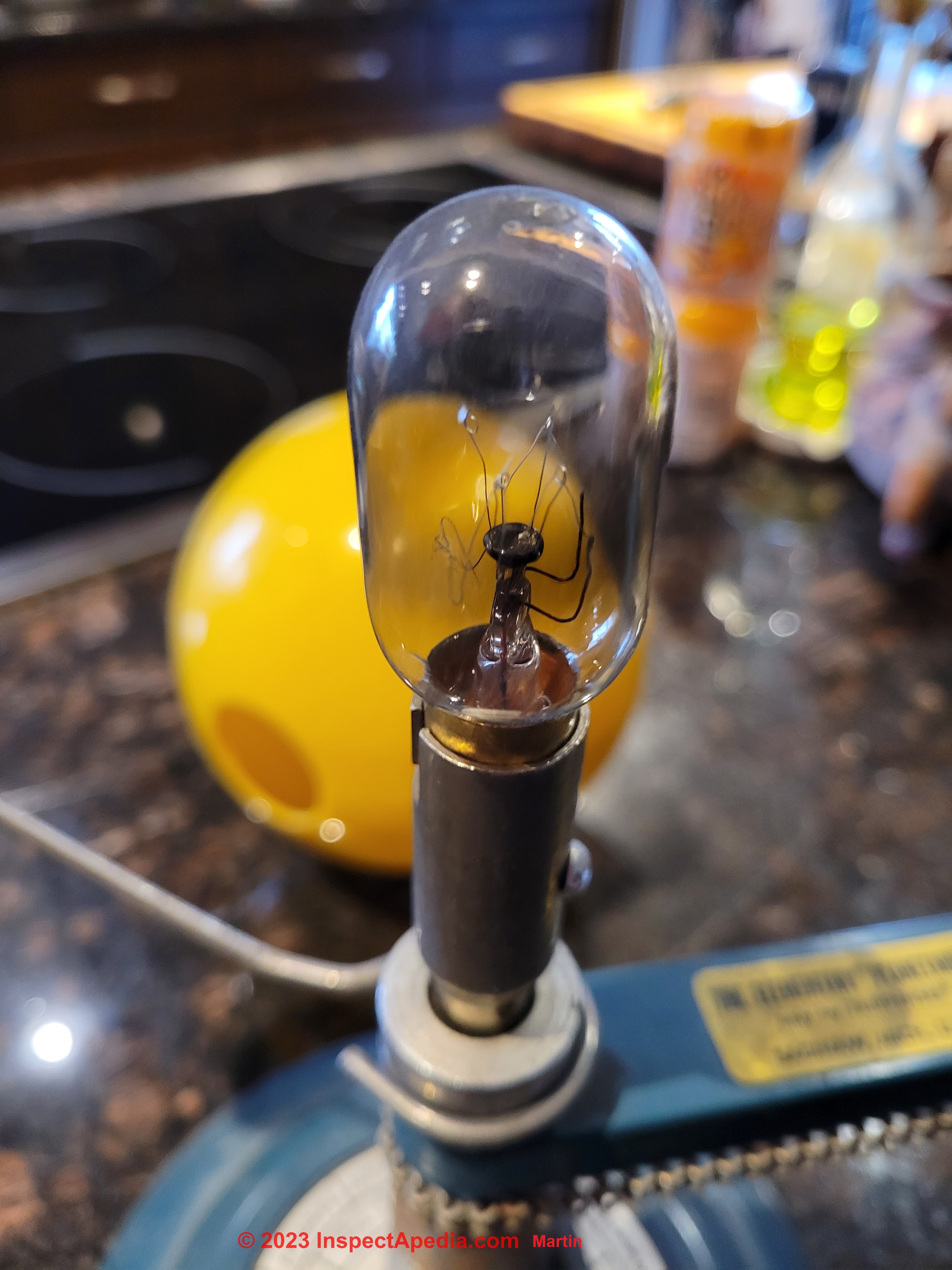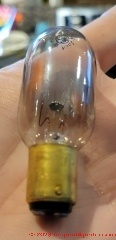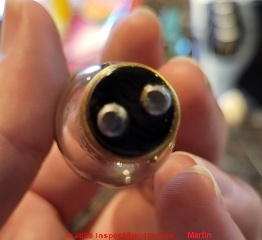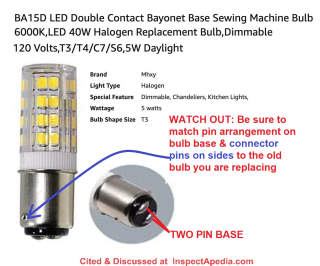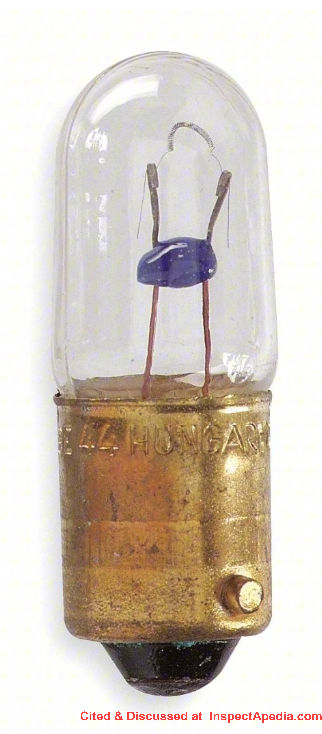
Bayonet Base Light Bulb
Types & Choices
Select and install bayonet base type light bulbs
- POST a QUESTION or COMMENT about bayonet base light bulbs & lighting types for use inside or outside of buildings
Guide to selecting & installing bayonet base type light bulbs used in building light fixtures and other devices.
This article series describes types of bulbs or lamps based on all of their properties & uses in and around buildings.
InspectAPedia tolerates no conflicts of interest. We have no relationship with advertisers, products, or services discussed at this website.
- Daniel Friedman, Publisher/Editor/Author - See WHO ARE WE?
Choosing & Installing Bayonet-Base Bulbs & Lamps
A bayonet base lamp or bulb is one which is pushed into and then held in place in its electrical socket by two pins projecting from the sides of the bulb base. Usually the bulb will have one or two electrical contacts on its base, but in more complex bulbs, such as may be common on cars and other vehicles, multiple contacts on the bulb base permit lighting of different filaments in the bulb for different purposes such as different levels of brightness.
Our page top photo of a simple GE bayonet base T3-1/3 bulb (that's the bulb's shape) uses a bulb base called a Miniature Bayonet (BA9s) that sports a single electrical contact. That's a 5-watt incandescent bulb. Bulb nomenclature isn't as horrible as it seems. The "T" simply refers to a roughly tubular bulb shape.
Key Features to Match when Replacing a Bayonet-base Bulb
Above: types of base found on bayonet type bulbs, adapted from bulbs.com, a source of nearly all types of light bulbs or lamps.
Watch out: notice that the side locking pins on these bayonet bulbs may be directly opposite one another (BA15D) or offset. Those bulbs are not interchangeable.
The Index Double Contact bayonet bulb base at the right end of our illustration may also be described in some bulb codes as a BAY15D (1157) dual contact bayonet bulb.
[Click to enlarge any image]
Note these key features:
- Bulb base connecting pins
Two on opposite sides of the base, at the same height, or two pins on opposite sides of the base but at different heights - Bulb base bottom contacts
Number of contact points, usually 1 or two but more in some applications
Here we compare three common light source types for bayonet base bulbs: as shown in order: traditional filament or incandescent bayonet base bulb,
a halogen bayonet base bulb, and
an LED bayonet base bulb, all of the same approximate shape.
Our first example is a SATCO S3906 25T7.DC 15W T7 Clear BA15D bulb.
Alternatives to these include krypton/zenon bulbs (not shown). All of these are dual-contact BA15d base bulbs, as you can see by noting the two silver contact points at the base of each.
- Bulb light source type
Traditional filament or incandescent vs. LED bulbs, but see our note below at Bulb Wattage where we discuss swapping an LED bulb for an incandescent unit - Bulb voltage
Don't stick a 12-volt automotive bulb into a 120-volt or 240-volt appliance socket even if it "fits" - it will burn up immediately.
For a 120V fixture use a 120V bulb, for a 12-volt fixture use a 12-volt rated bulb. - Bulb wattage
If you're using the same bulb light source type, e.g. incandescent, you probably want to match the original bulb wattage - usually printed on the bulb.
But note that you can often replace an incandescent bulb of a given wattage with an LED bulb whose light output (in lumens) is equivalent but that uses considerably less energy - the bulb operates at a lower actual wattage and usually gives off less heat as well.
- Bulb shape and actual size
The shape of the lamp or bulb is critical in some applications such as in a sewing machine, vacuum cleaner, or lab instrument where larger or bulged shaped bulbs may not fit.
For other applications, such as inside of a roomy floor lamp or light fixture, bulb shape may not matter - making finding a replacement easier.
Below, adapted from grainger.com, we show common bulb shapes T, S, G, B and spot/flood.
Note that while bayonet bulbs are widely used in automotive applications, here we're focused on bayonet base bulbs used in buildings or in building appliances, tools, and fixtures.
Watch out: For critical applications where a bulb has to fit into a confined space exactly, check the manufacturer's specifications where you'll find the exact size. For example, the USHIO bulb shown just below is described in detail at bulbamerica.com as:
The Ushio CAX/130V replacement bulb has a part number of BC8339. This Ushio bulb has an ANSI code of CAX/130V. The bulb type of this Ushio CAX/130V lamp is type T-8. The base type of the Ushio CAX/130V replacement bulb may also be called T8.
The Ushio CAX/130V replacement lamp has a base type of BA15d (Double Contact Bayonet). This Ushio CAX/130V bulb is a 50 watt bulb.
The Ushio CAX/130V bulb is a 130 volt bulb.
The maximum overall length of the Ushio CAX/130V replacement lamp is 3.100 inches or 78.7 millimeters. The bulb diameter of the Ushio CAX/130V replacement lamp is 0.984 inches or 25.0 millimeters.
The light center length of this Ushio CAX/130V bulb is 1.400 inches or 35.6 millimeters.
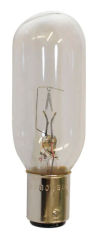
Above, the manufacturer of this incandescent BA15d is USHIO who describes this as a USHIO CAX/130V 50W BA15d Base Incandescent Projection Lamp Tubular Bulb. The manufacturer says that the base type of the Ushio CAX/130V replacement bulb may also be called T8.
...
Reader Comments, Questions & Answers About The Article Above
Below you will find questions and answers previously posted on this page at its page bottom reader comment box.
Reader Q&A - also see RECOMMENDED ARTICLES & FAQs
Reader Question: help me find a replacement for this antique bulb used in a classroom Solar System model
Im a Gr7 Science teacher from Toronto, and wonder if you could help me out identify a old ass bulb.
It comes from a light up Solar System model from the late seventies, and I'm enabled to find bulbs that are exactly the same size and shape and wattage, but the connector piece is vastly different.
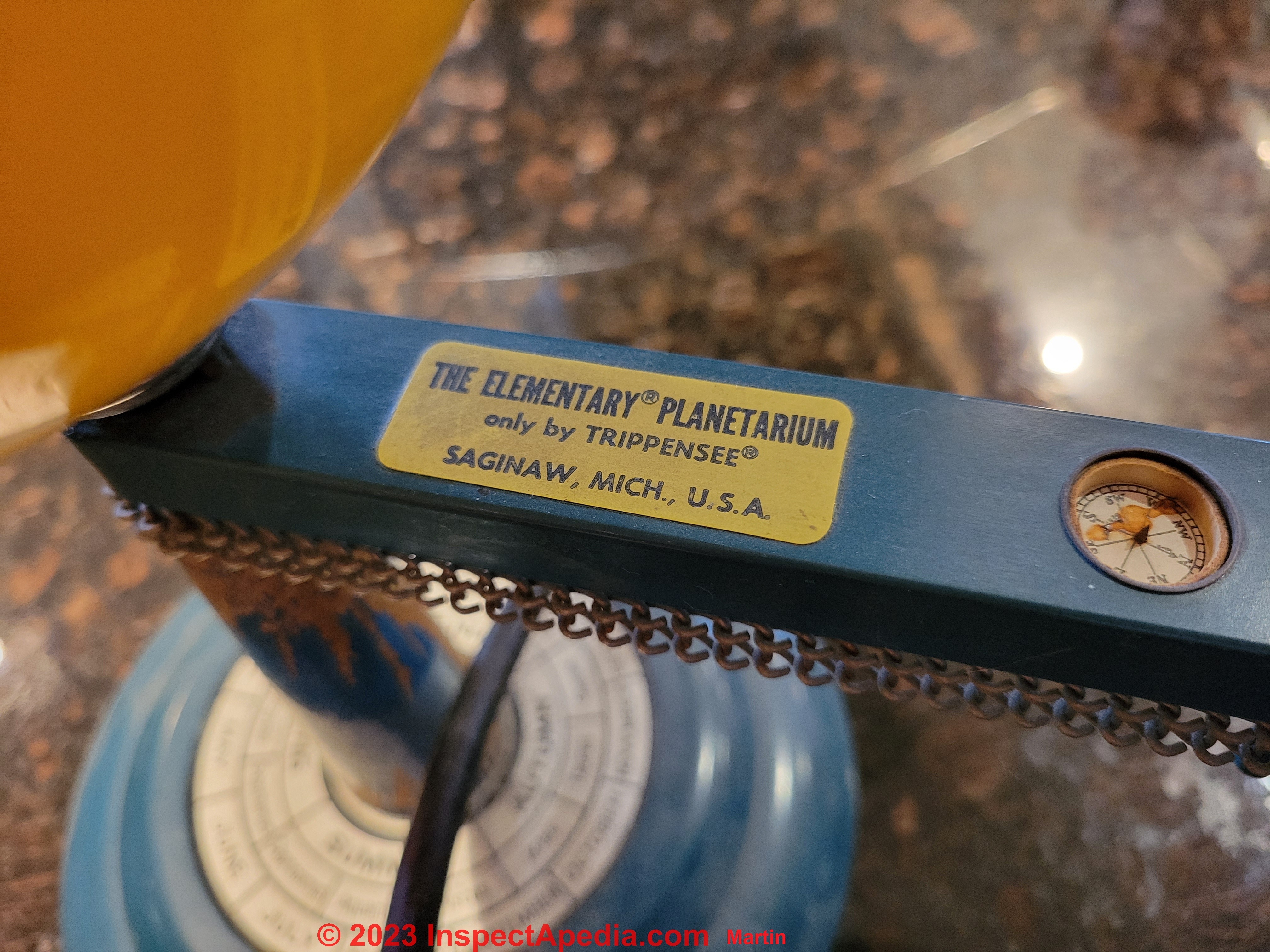
Been looking for a while now, hopefully you'll be able to help. - Anonymous by private email, 2023/04/30
Above: burnt-out lamp or light bulb for the "Elementary Planetarium" by Trippensee in Saginaw, Michigan.
Moderator reply:
Sure Tim, it's easier than you might think to find a replacement bulb that will work in that 1970s Solar System Model.
Above: the side and bottom view show us both the side contact pin positions and bottom contacts for this bulb.
Critical bulb features to match when finding a replacement lamp
- bulb base type - this is how the bulb connects to its socket;
if you could not find a matching bulb base you'd have to re-wire the fixture to install a new bulb base to accept a new bulb - we'll avoid that if possible
Your bulb has two contact pins on the underside or "bottom" of the bulb base
Your bulb has two locking pins, one on each opposing side of its copper base, and each pin is the same distance "up" from the bulb's bottom.- bulb voltage - if your fixture plugs into a conventional wall receptacle in a country where the voltage is 120VAC then you need a nominal 120V bulb.
- bulb wattage - it's best to get the same or close wattage and brightness as the original bulb; lower is safe, higher wattage may not be safe
- bulb shape - for some fixtures the shape of the bulb matters. For your solar system globe it probably doesn't matter much as it fits inside of a large globe, but the bulb is a tube shape or a "T" Bulb
- bulb light source type - may not be critical depending on the application.
Your bulb uses traditional filaments - it's an incandescent bulb.We can replace lots of incandescent bulbs (that's yours, making light with a wire filament that heats up and gives off light) with an LED bulb - more on that later; and, if the original bulb is LED, so should be its replacement.
First look at the bulb's base shape and features to get the general type of bulb needed, as that avoids having to re-wire the Solar System model to accept a new bulb + new base - that would be the option of last resort.
I see that the bulb base has two contact points so it's "twin contact".
When choosing a replacement bayonet-base bulb, take care to notice the position of the two locking pins on the sides of the base. There are two different designs.
1. Side Pins at Same Height: the pins are on opposite sides of the base, both at the same distance from (and close to) the bottom of the base. (BA15D)
2. Side Pins at Offset Height: the pins are on opposite sides of the base, but are staggered, one pin is near the bottom of the base and the other on the other side is higher up from the base.
This bulb can be inserted into its receiving socket in only one position and is used where polarity of the bulb circuit or the use of its bottom contacts varies and so, position matters.
That's called an Index Double Contact Bayonet base bulb.
In your photos, I think we see that the sides of your old bulb base have two pins on opposite sides, so it's a "double contact bayonet base" probably type BA15D where the "D" means double contact.
The base diameter and height will be important in matching a bulb that will fit perfectly into the existing fixture socket. So you might also measure those parameters and pass those on as well.
The bulb shape is a T-type, perhaps a T3, but keep in mind that if you get the wattage essentially right and the base right, you don't have to match the bulb shape exactly.
"T" shaped bulbs just means that the bulb is "tubular" in shape. Your replacement bulb still needs to fit successfully into the fixture. So, noting the overall measurements of the original bulb will be helpful.
That shape is still made. For example: bulbs.com shows this bulb that might be an exact match:
Luckily, I think some of the writing atop the burnt-out bulb you have in hand is still legible. Read it and tell me what you see.
I think you're going to see that it's a nominally 120VAC rated incandescent bulb - but knowing the wattage would be helpful.
Match Original Bulb Wattage
Sometimes the wattage is also stamped on the copper bulb base in ink or as an embossed number followed by a W
There are two reasons to consider the wattage:
1. Match the original brightness required by the purpose of the bulb and fixture
- you don't want your fixture to be too dim, and2. Avoid fire risk:
On the other hand, if you replace the bulb with one of much greater wattage, there could be a fire hazard or a risk that the heat from the higher-wattage bulb damages the fixture - melts plastic nearby, for example.
Match Bulb filament design for incandescent bulbs?You'll see that replacement incandescent bulbs are sold in a variety of filament designs that for your purposes - used inside of a globe - don't matter much.
The filament design may be more important for bulbs used as exposed, for decorative purposes, or where other special filament features are needed.
Swap in an LED Bulb for an Incandescent Bulb
But there's a clever update that you should consider where exposed filament appearance is not of interest (your case).
You can usually find an LED equivalent replacement bulb in just about any bulb connection base and voltage. The LED replacement will offer some significant advantages if it's brightness in lumens is anywhere close to the original
1. an LED bulb runs cooler - so there's no fire nor overheat risk
2. an LED bulb uses much less electricity - saving energy
3. an LED bulb may have a much longer use-life
Below would be my first choice for a replacement bulb for the one about which you inquire - it is a BA15D LED replacement bulb, equivalent to a 40Watt incandescent bulb in light output but using only about 5 watts of actual power. If this bulb's wattage is around that of your solar system model globe, it could be a perfect choice.
So if the 40Watt brightness rating of this 5-Watt LED BA15D bulb is bright enough for your classroom use it would be a good update for your solar system model.
...
Continue reading at BULB & LAMP TYPES GUIDE or select a topic from the closely-related articles below, or see the complete ARTICLE INDEX.
Or see these
Recommended Articles
- BULB & LAMP TYPES GUIDE - home
- ANTIQUE LAMPS (BULBS) & CONNECTOR TYPES
- ANTIQUE LAMPS (BULBS) LIGHT OUTPUT - LUMENS
- ASBESTOS in LAMPS & LIGHT BULBS
- BAYONET BASE BULB TYPES
- BULB & LAMP ABBREVIATIONS & CODES
- BULB COLOR TEMPERATURE COMPRARISONS
- BULB COLOR TEMPERATURE U CRI
- BULB CRI SCALE DEFINITION & RATES
- COMPACT FLUORESCENTS INDOORS
- FLUORESCENT LIGHT BULB CODES & TYPES
- FLUORESCENT LIGHT REPAIRS
- FLUORESCENT vs INCANDESCENT BULBS
- HALOGEN LIGHTS INDOOR USES
- INCANDESCENT BULB GUIDE
- LAMPS (BULBS) ANTIQUE CONNECTOR TYPES
- LED BULB & LIGHTING TYPES
- RECESSED & TRACK LIGHT BULB GUIDE
- LIGHTING, EXTERIOR GUIDE - home
- LIGHTING, INTERIOR GUIDE - home
Suggested citation for this web page
BAYONET BASE BULB TYPES at InspectApedia.com - online encyclopedia of building & environmental inspection, testing, diagnosis, repair, & problem prevention advice.
Or see this
INDEX to RELATED ARTICLES: ARTICLE INDEX to BUILDING LIGHTING
Or use the SEARCH BOX found below to Ask a Question or Search InspectApedia
Ask a Question or Search InspectApedia
Try the search box just below, or if you prefer, post a question or comment in the Comments box below and we will respond promptly.
Search the InspectApedia website
Note: appearance of your Comment below may be delayed: if your comment contains an image, photograph, web link, or text that looks to the software as if it might be a web link, your posting will appear after it has been approved by a moderator. Apologies for the delay.
Only one image can be added per comment but you can post as many comments, and therefore images, as you like.
You will not receive a notification when a response to your question has been posted.
Please bookmark this page to make it easy for you to check back for our response.
IF above you see "Comment Form is loading comments..." then COMMENT BOX - countable.ca / bawkbox.com IS NOT WORKING.
In any case you are welcome to send an email directly to us at InspectApedia.com at editor@inspectApedia.com
We'll reply to you directly. Please help us help you by noting, in your email, the URL of the InspectApedia page where you wanted to comment.
Citations & References
In addition to any citations in the article above, a full list is available on request.
- Our recommended books about building & mechanical systems design, inspection, problem diagnosis, and repair, and about indoor environment and IAQ testing, diagnosis, and cleanup are at the InspectAPedia Bookstore. Also see our Book Reviews - InspectAPedia.
- In addition to citations & references found in this article, see the research citations given at the end of the related articles found at our suggested
CONTINUE READING or RECOMMENDED ARTICLES.
- Carson, Dunlop & Associates Ltd., 120 Carlton Street Suite 407, Toronto ON M5A 4K2. Tel: (416) 964-9415 1-800-268-7070 Email: info@carsondunlop.com. Alan Carson is a past president of ASHI, the American Society of Home Inspectors.
Thanks to Alan Carson and Bob Dunlop, for permission for InspectAPedia to use text excerpts from The HOME REFERENCE BOOK - the Encyclopedia of Homes and to use illustrations from The ILLUSTRATED HOME .
Carson Dunlop Associates provides extensive home inspection education and report writing material. In gratitude we provide links to tsome Carson Dunlop Associates products and services.


